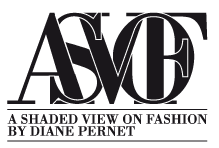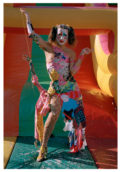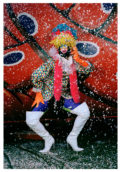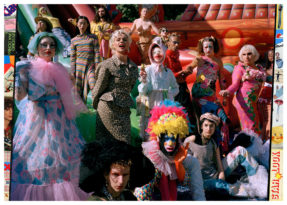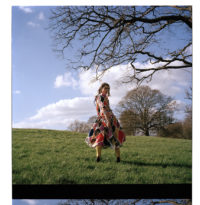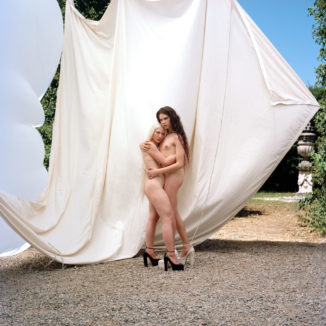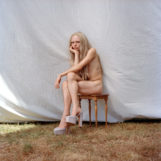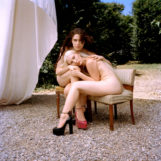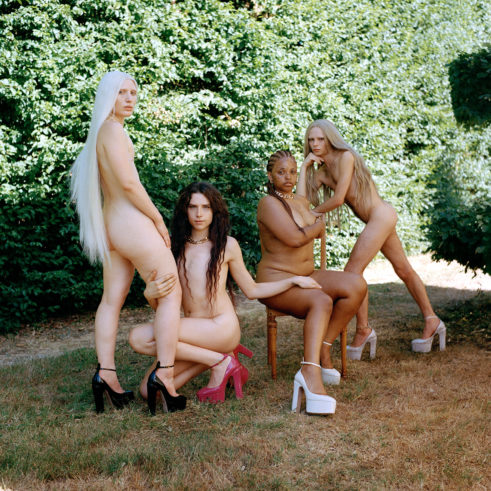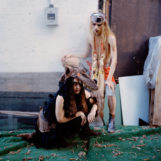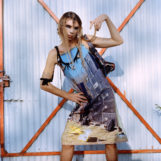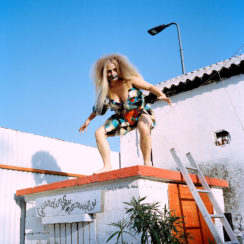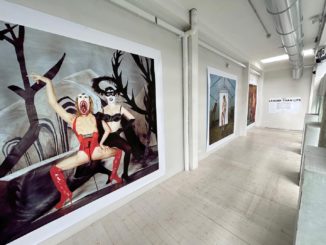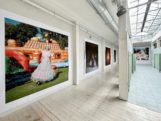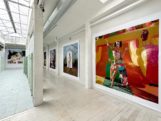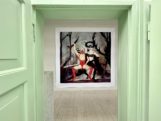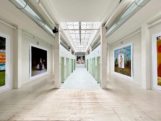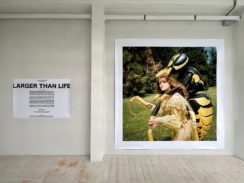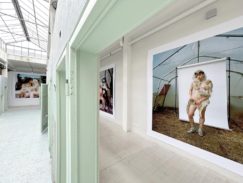Dear Shaded Viewers,
Franca Soncini sat down with the founder of Coriandoli Magazine. Alessandro Merlo was born in Italy 27 years ago. They lived in London from 2014 to 2020 and they now live and work in Milan, where they take on various artistic practices.
Alessandro is a polyhedric creature: photographer, artist, art director, founder of Coriandoli Magazine (a yearly magazine), writer, charismatic figure of the Queer scene and nightlife.
Alessandro is special: dressed in whichever outfit, they carry their ‘diversity’ (granted such concept even exists) with fierce pride and joy, and they are not scared to be simply who they are.
FS: Tell me about Coriandoli magazine…
AM: I founded Coriandoli Magazine because I wanted to fill an editorial void, as well as a physical one. I noticed certain voices weren’t being heard, certain ways of existing weren’t being seen, not just in publishing but also in public life. I put together people with a similar sensibility to create the magazine and occupy a portion of the Milanese and Italian scene, in order to inspire people and encourage them to express themselves and live out loud artistically and ironically.
FS: So Coriandoli is also a community?
AM: Yes, Coriandoli is a proxy for the Italian Queer community, who I hope will be able to identify in what we are doing in some way, and even if they don’t – I need Coriandoli to exist for my own sanity.
FS: Great photographers such as Nan Goldin were very close to the Queer community in a time where a terrible disease and drug abuse was taking their life. Nan narrated their hardships through her photographs: they were outcasts and led extremely miserable lives. On the other hand, Coriandoli tells the tale of a joyful, ironic, thought-provoking world. Did things really took such a decisive turn?
AM: I think it’s necessary to paint our life this way. For the longest time, the Queer community has been cast in the shadows by all these issues related to sexuality, healthcare, religion – centred around a sense of guilt and darkness that forced us to hide. That is not the case anymore, on the contrary: I think it is necessary to redefine the meaning of what it means to be a Queer person and I tried to define it in this colourful, very visible way. We are not interested in hiding who we are, we are not going to pathologize our sexual or gender preferences, we want to live our life and be happy just like every other person. Our goal is to shake things up in a positive way while provoking our audience, in the same way that a clown is able to put a mirror in front of you to show your fears are simply ridiculous.
FS: On the other hand, it is hard to deny that these days we usually witness a strong opposition to minority groups – in Italy and elsewhere. Very bad things are happening on a political level.
AM: Of course, this is increasingly being discussed – especially since the advent of the Meloni government. Personally, I think this is an undesirable but necessary step in the advancement of human rights: when they are pushed forward, reactionary forces try to bring progress back, so in a way the backlash could be seen as a positive sign – considering LGBT rights were hardly ever discussed with this level of involvement from both sides. Of course, this leads to horrible real-life consequences for Queer people: only yesterday we witnessed the Italian government disavowing 33 children born into same-sex families. This is obviously extremely sad, but we must take this as an opportunity to re-assess our demands and organise our activism in order to achieve tangible political goals on a law-making level. The culture wars often lead us to lose sight of the fact that our goal isn’t necessarily to be seen as valid by every single person on Earth: ignorant and disrespectful people will always exist and it’s impossible to eradicate them out of existence, but we need to at least achieve solid protection from the government through laws. I understand the retaliation from the political class is scary and not everyone is going to get on board with something they are so unfamiliar with, but we must make a dent deep enough in the legal system in order to be able to live our life like everybody else.
FS: Let’s talk about you as a photographer and artist. When I saw your Valentino campaign – such strong images featuring naked non-conforming bodies in the context of a mainstream luxury brand – I thought it was amazing. It could also be seen as opportunistic: a certain class is able to feature anything for publicity, as long as people talk about it. This happens a lot in advertisement, especially fashion advertisement, don’t you think?
AM: I think every little step – even a corporate one – towards our direction can be seen as a victory. We went from being censored, demonised and cast away from society to having some kind of selling power. That is definitely a first in the arena of marketing and advertisement. My job has to do with aesthetics and I work with big and small brands alike – this was a major opportunity and I had to make the most of it, whatever the brand’s intentions were. Overall, I feel positive about having worked with a team who pushed me to go towards a more provocative direction and I certainly didn’t pull back. This campaign had real consequences in terms of impact and visibility: models from the cast were contacted from people who asked them about their transition and surgeries, the project was seen and welcomed by the global community as something beautiful, progressive, artistic, it was understood as something that celebrated the body in its various manifestations and I think the message came through in the way I intended. Having said that, we noticed from the several negative comments we received on social media that most people are still not ready to be confronted with nonconforming bodies who are not afraid to expose themselves. That is, of course, not my problem.
FS: How did the Valentino executives react when they saw the images?
AM: I didn’t speak directly to Pierpaolo Piccioli but his team was present at the shoot and they were sending him photos in real time as we were shooting. They wanted me to shoot this project and we all agreed upon the same brief, so I didn’t feel any resistance and nobody tried to change our direction.
FS: Other collaborations?
AM: There are many other brands and magazines I collaborate with. I am usually inclined to portray artists, performers or independent designers: most of my photographs can be seen as a collaboration with them. I built a certain credibility within the scene that allows my subjects to trust the way they are going to be represented within my work. You can see many examples of this on the first issue of Coriandoli. I am definitely less interested in portraying models wearing clothes that don’t resonate with them and don’t reflect their style. I love working with artists, my idea for Coriandoli is to bring in front of my camera people who want to tell their own story through their personality and aesthetic sense.
FS: I came to the Luxor’s fashion show organised by Coriandoli a few months ago, I had so much fun, it’s very unusual to see something like that in Milan, I felt like I was in London! What kind of involvement did you have in the collection?
AM: First of all I have to point out that Coriandoli is also a collective in which many people contribute in different ways to a varying degree of involvement. For example, Coriandoli’s art director Riccardo Cerulli – aka Caledonia Asbesthos aka Luxor’s – created a collection of clothes under the Luxor’s label that are intimately intertwined with Coriandoli’s visual language. My experience in London has been vital to my learning curve: I was friends with a community of people who create their own clothes in their own room with different skillsets and techniques, questioning concepts of wearability, disposability, taste and decorum. The clothes we presented take inspiration from that DIY approach to fashion, straying away from marketing strategies, seasonal logic and gendered mentality. We wanted to bring an alternative to the usual Milanese fashion happenings. We see fashion as artistic expression and we didn’t care about producing huge amounts of clothing to be stocked and sold in shops, even though a few selected stores came through with orders and Luxor’s received commissions from different kinds of clients from different parts of Italy. Many requested personalised custom looks, which is exactly what we wanted.
FS: Let’s talk about your recent solo show held in Milan at Teatro Franco Parenti, a show that was warmly welcomed and put you in the spotlight as a rising stars in the field of photography.
AM: This was my first show in Italy and my first solo show ever (I previously held collective shows in London and Paris). ‘Larger Than Life’ was a very emotional experience for me, I used to have a hard time defining myself as an artist – maybe due to my photography background – but when I saw my work printed in that huge 3mx3m format, well – I hope I don’t sound too pretentious but I thought they were real works of art. Welcoming all those people in such a beautiful location was an amazing experience.
FS: Is there anything else you would like to add?
AM: I would like to tell whoever is reading this interview that it’s not important to define yourself in any particular way. You must do things you love and you must not fear. For example, I created Coriandoli magazine without being a journalist or a writer, but I did it anyway and we pulled it off really well. I would like to encourage anyone to express what they feel in whichever way they desire, and then just release it into the universe and let it be. The system currently in place can be frustrating, it doesn’t allow you to dare. It is extremely important to share what you create with other people. At the end of the day, we all want to be understood and recognised for our efforts. The least amount of filters between our inner sensibility and our output, the more we can express and leave a mark on the outside world.
Franca Soncini
